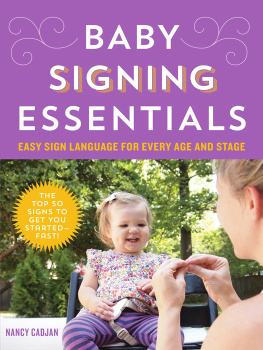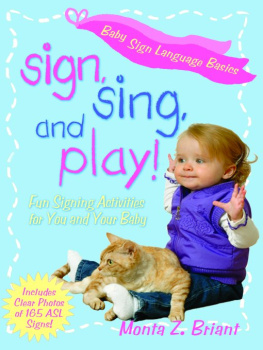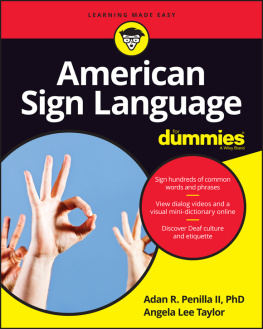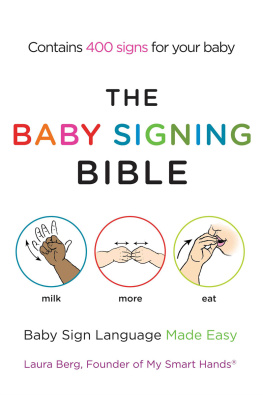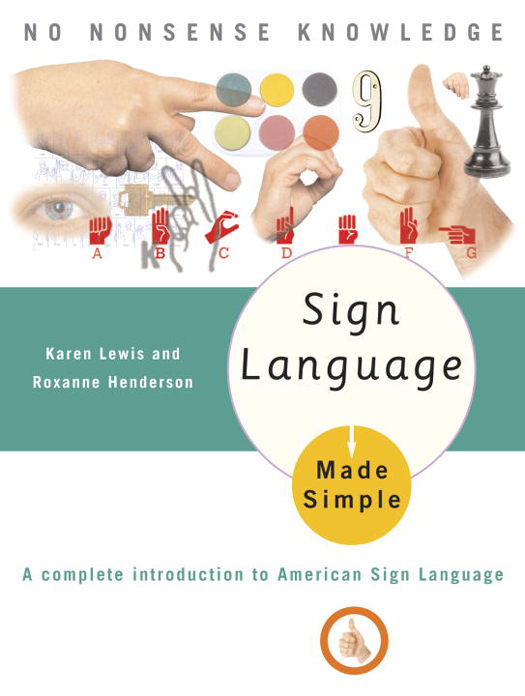Copyright 1997 by Three Rivers Press, an imprint of the Crown Publishing Group, a division of Random House, Inc. All rights reserved.
Published in the United States by Three Rivers Press, an imprint of the Crown Publishing Group, a division of Random House, Inc., New York.
www.crownpublishing.com THREE RIVERS PRESS and the Tugboat design are registered trademarks of Random House, Inc. Originally published in in hardcover in the United States by Doubleday, a division of Random House, Inc., New York, in 1997, and subsequently published in paperback in the United States by Broadway Books, an imprint of the Doubleday Broadway Publishing Group, a division of Random House, Inc., New York, in 2001. The Library of Congress Cataloging-in-Publication Data has cataloged the Doubleday edition as: Lewis, Karen B. Sign language made simple/Karen B. 1st ed.
p. cm.
A Made Simple Book
1. cm.
A Made Simple Book
1.
American Sign LanguageStudy and teaching. I. Henderson, Roxanne.
II. Philip Lief Group. III. Title.
HV2474.L48 1997
419dc21 97-9233 eISBN: 978-0-307-82326-7 v3.1
Table of Contents
I. Introduction
What Is Sign Language?
Any person who studies a second language quickly learns that there is a great deal more to the task than learning new words for things. Languages have their own structure, logic, and flavor their own personality. They follow particular rules of use on everything from how to express tense (past, present, and future) to syntax (the order of the words), and many other elements. This is as true for sign language as it is for spoken language. Or is it? Can handshapes and movements really be a form of language? Sure, people of all cultures use their hands to enhance their speech, and in some cultures hand gestures are used in well-defined and highly specific ways.
Many international travelers have learned through embarrassing experiences that a gesture that means ?-OK in one country is a rude vulgarity in another. Even so, these gestures are not language. Sign is language, though, precisely because it is so much more than a collection of gestures. It is an organized set of rules and symbols used to communicate information, ideas, and feelings (which is actually a pretty workable definition of language in general). This book focuses on American Sign Language (ASL), the major sign language used by deaf people throughout North America. As you move through this book and learn how to use ASL, the fact that it is a real language quickly becomes obvious.
However, linguists and educators of the deaf have not always agreed on this point. The English word language comes from the Latin lingua which means, literally, tongue, and for a long time linguists considered the two to be inseparable. For much of this century, teaching programs for deaf children de-emphasized or even forbade signing. Educators of the deaf, meaning well, struggled valiantly to normalize nonhearing students by teaching them to use spoken English, at any cost. The cost, too often, was and is alienation and low academic achievement by deaf students. Signing was thought to be a weak translation and therefore a poor substitute for the language of the signers native culture.
Real language was spoken and written, not gestured. Signing was considered inferior, what people did if they couldnt master the real thing. Signing was dismissed as mere picture drawing (iconography), efficient in what it did, but still not language. One could, however, make the same claim against spoken language. Consider the definition of onomatopoeia, i.e., a word that sounds like the thing it describes. Buzz is one, as are hiss and zip.
Some theories about speech suggest that the first attempts by humans at spoken language were all onomatopoetic. Does that in any way debase our present-day speech? Of course not. Spoken language is much more than a string of onomatopoeia and sign language, much more than pictures drawn in the air. In fact, many studies have looked at whether signing is just pantomime, and they all arrived at the same answer: No. While some signs have a clear representational connection to the things they describe, others have a more tentative one, and just as often the connection is weak or nonexistent. Signing dictionaries, including ours, allude to these iconic connections, which may be useful as memory aids.
But beyond that, making too much of the picture-link does tend to narrow the meaning of a sign that may have several related but nonidentical meanings. While fluent signers use simple pantomime in humorous and poetic ways, and to spice up discourse in a metaphorical way, so do people everywhere in all forms of speech. But sign is not simply pantomime. If it were, anyone of minimal intelligence who paid attention could and would understand signs. In reality, nonsigners who observe signed discourse understand nothing or very little of it, and signers in one sign language do not automatically understand signs in another. The truth is, our knowledge of the origins of many individual signs, just like our knowledge of many English words, is murky at best.
What we know is that sign language first originated in residential schools for the deaf. Ironically, bringing deaf children together in groups, at least partially for the purpose of being taught spoken language, caused signing to flourish as never before. For most of the 19th century, sign language passed primarily from child to child, and in instances of a deaf child having a deaf parent, signing was passed down from generation to generation. Sign languages evolved as all languages do, idiomatically and idiosyncratically. To this day, little linguistic integrity exists beyond national borders, which usually also represent the boundaries of spoken languages. For instance, signers in France communicate differently from and cannot be understood by those in Germany.
On the other hand, signers in the United States and Canada share pretty much the same ASL, although there are many regional differences. These regional differences become obvious to the signer who learns ASL in one part of the country and uses it another. The author of this book, Karen B. Lewis, is an interpreter (not deaf, of course) and teacher of Sign and interpreting. She studied at Gallaudet University, in Washington, D.C., and has worked most of her signing career in North Carolina, where she interacts with the deaf and signers from all over the United States and Canada. Drawing on her vast experience, this book tries to span all regions of our nation; yet inevitably some signers will find some of our signs foreign.
We have not attempted to be utterly exhaustive or to list every ASL sign past and present, much less every small variation of these signs. That is a task we will leave to the academics and linguists. The goal of this compendium is to get the beginning signer started. Which signs and variants to include has always plagued compilers of anthologies such as ours. One nonregional, universal sign language simply does not exist. Even within ASL, which is a fairly standard language throughout the United States and Canada, significant regional differences exist.
The codifying and teaching of ASL as well as its status as a legitimate language are just too new. Similarly, ASL has no standard, workable written form. Many academicians at various times have attempted to encrypt ASL, but the usefulness of this is considered to be very limited; after all, as written discourse, English will always be preferred. Overall, with the possible exception of what comes out of Gallaudet University (more on GU later), there simply is no Queens English version of ASL, either on paper or in signing. It is first and foremost a language of face-to-face discourse. Nevertheless, ASL does have an extensive vocabulary.



